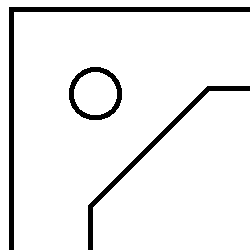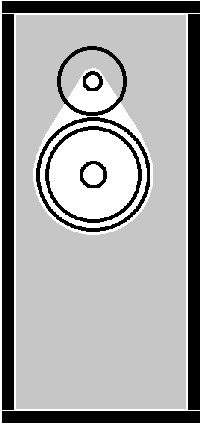The long-awaited HUMAN 81 DK is now available.
Best viewed in "landscape" mode.
How to: build speaker grills
There are four approaches to the final cosmetic touch on your speaker project - covering the front (or sides) where the drivers are mounted in an attractive fashion.
One is the method I always used in my own DIY days, which was to do nothing. The speakers played, so I was done working on them. This solution does not require any instructions.
The most popular and attractive solutions are to either make a panel from wooden material about 1/2" thick and mount it with plastic pegs and sockets, like most modern speakers; or to make a 1/4" Masonite (hardboard) panel and attach it with nails or Velcro, in the fashion of some older speakers. Each style has its advantages and disadvantages.
The fourth is to take the PA or "industrial" approach to your cosmetics and put big nasty rugged metal grills over the drivers. I think this approach also requires no explanation from me. On my HUMAN car speakers, though, I do stretch grill cloth over the underlying metal to make them more attractive and protect the drivers (somewhat) from the environment.
The wooden frame based grill can look very sharp and professional. They are very nice when a large fine finished box is only "grilled" over the drivers, leaving as much wood showing as possible. Particle board is the best material to use because it machines easily, is fairly lightweight, and will not warp, as grained or asymmetrical wood products can.
They should be cut to a quarter round on the outer edge so the cloth wraps nicely, and the inner edge should be made so as to reduce the "cupped hands" effect of reflecting the drivers' sound as it spreads out. One way is to cut them so they have a 45 degree angle on the inside, another is to cut them at 90 degrees and add a thick chunk of felt damping material, leaving plenty of room in front of and around the drviers, of course. Here is a sketch of a cross section of one side rail to try to show what I am describing:

The plastic pegs that are used to hold them on are a nice feature. They allow easy removal for cleaning, and so long as they are not beaten on they will last indefinitely. Typically the peg goes in a 7/16" hole in the grill, and the socket in a 9/16" hole in the cabinet. Of course you should be careful to line these holes up with each other! It is also nice if you take the effort to make your grills identical, so you don't have to keep track of which one fits which speaker. If they are vertically symmetrical, they will go on either way up as well, if you make sure the hole pattern is equally symmetrical.
The trick to doing this is to use a little jig to drill a small pilot hole in each corner of the grill so they are identical, and then carefully clamp the grills to the cabinet to drill pilot holes in the box. Then you follow the pilot with the 7/16" and 9/16" drills. Now everything will line up and be interchangeable.
I prefer to wait until after attaching the cloth to the frame to install the pegs, since they can interfere with that process somewhat.
| It is best to leave the corners wider in order to have some "meat" where the mounting pegs will be installed, as shown to the right.
On a long grill, two more pegs near the middle of the long sides will help keep things manageable, and if there is enough space between the drivers, a piece of wood can be left in to act as a brace. This piece should be cut to the same 45 degree angle as the rest of the inner grill edges. Of course, this should not be an issue with the systems I promote, since they use small diameter drivers mounted very close together. |
 |
(note: I think "Masonite" is a trademarked brand name for a certain product, and I know "Velcro" is. I hope they don't mind me using their names generically in this fashion!)
The Masonite or hardboard type of frame works well if you are covering the entire face of a speaker, with perhaps a nice piece of wood trim around left showing around the edge. The trim can be designed to stick out the same amount as the masonite, with cloth, for a clean look. If you seriously want to re-create the "vintage EPI" look, a small brass rail inside the trim is de rigeur, of course!
1/4" Masonite is about right, since the thinner stuff might tend to warp too easily.
|
Usually you would cut the frames just slightly smaller than the space inside the trim (to allow room for the cloth to wrap around), and cut a rough hole big enough to expose the drivers properly. This can make the frame a bit weak, if the drivers are close to the edge of the box. There is an attempt to show what I mean by this, to the right. This diagram assumes that the tweeter plate has been rabbetted flush with the front of the baffle, so the grill can overlap it.
The frames can be nailed to the speaker cabinets with small panelling or finish nails, but this does make them difficult to remove for repairs or cleaning. The nails will generally be hidden by the cloth, but work best if they are dark and the cloth has a coarse weave so the nails can "vanish" under it. I wouldn't recommend nailing a grill wrapped with a cloth that had a finer weave than the size of the nail head. Pieces of Velcro in the corners, and the middle of long edges, will work reasonably well, although it can be difficult to attach well enough that it holds to the grill and box better than it holds to itself! |
 |
Once you have decided on a frame style, it is time to pick some cloth to finish them off nicely. It is usually best to paint the frames black so they do not show through the cloth later.
Cloth can be easy or difficult to find, depending on your luck. A few electronics suppliers have it for sale on line. Some fabric stores actually have black "grill cloth" in stock, which is handy. Go to a fabric store and ask. If they don't have grill cloth, "single knit polyester" works well and is usually available in a small variety of attractive or garish colors as well as your basic black.
Whatever your browsing leads you to, grill cloth should exhibit two features: one, it should stretch quite well in both directions, so you can attach it to your frames nice and tightly, sag and wrinkle free; and two, it should be easy to "blow through" (I know this experiment can seem a bit gross, but you'll get over it). This is to determine if it will be reasonably transparent to sound.
Synthetic fabrics are usually the best - they are stretchy, readily found in light weights, and will adhere well if you use glue to hold them in place.
To attach the cloth to the frame, there are two methods - glue or staples. Forget staples if you used a masonite frame, it will be too thin to hold the staples well. You also will need a powerful stapler to penetrate particle board properly. I use a rubbery sort of contact cement, in the following manner.
Please note, the glue I am using here is not really available on the consumer market (I buy it directly from 3M, and have to get five gallons at a time). I have not tested various products that are on the consumer market at hardware stores, so I can't recommend a specific glue to use. What you want to find is a rubber cement/contact cement type glue that goes on fairly thin (so it is easy to spread out), and then gets tacky for a while before setting.
I put a series of photographs showing this process here for you to see. Warning - there are about 14 images, so it might take a minute or three to load for you.
First check the cloth for flaws like dirt or bad creases, then cut it to about 2-3 inches bigger than the frame, to make it manageable. If the two sides of the cloth are different in the appearance of their weave, lay them down in such a way that you can make each grill the same!
Then take one frame at a time, and working in a "well ventilated area," lay them face down and brush contact cement on the backside, in about a 1/2" wide swath all the way around close to the outer edge. Let the glue dry until it is tacky. Place one piece of the cloth neatly on a clean, hard surface. Lay the frame face down on it, reasonably well centered. Pull one corner of the cloth around and "stick" it on the glue well enough to hold it for a bit. Pull the diagonally opposite corner until the cloth is stretched a bit and likewise tack it in place. At this point the cloth will develop a big crease between these two corners, but it will go away in a moment. Do the same stretching and tacking trick on the remaining two corners, pulling out that crease in the middle, and using about the same amount of "stretch" as you did on the second corner.
Now pull the sides and ends of the fabric around the frame neatly, applying again a slight tension, and press them into the glue. If your fabric has the right amount of stretch to it, you can now "dress" the corners by lifting them up a bit and pulling harder to the center of the grill, so they actually lie flat as they go around the corner of the grill (on the back still). If the fabric is too heavy to do this, at least get it to lie fairly neatly, with no big folds at the very edge where they might show.
Go all around the glued area pressing firmly on the cloth to make sure it is well attached to the frame by the glue. Rubbing with the rounded handle end of a utility knife can work quite well for this. Then use a sharp knife to carefully cut off the excess cloth. Flip the grill over - does it look good? Now is the easiest time to remove the cloth and try again if necessary, while the glue is still tacky. If it "passes inspection," proceed to the other frame and piece of cloth. Do they look great? Of course they do!
* * *
Top - Contact
New Speakers -
EPI and Epicure - Genesis Physics
© Copyright - All Rights Reserved
![]()
7 Kelsey Road, Lee, New Hampshire 03861
Prices can change and specifications will improve without notice
